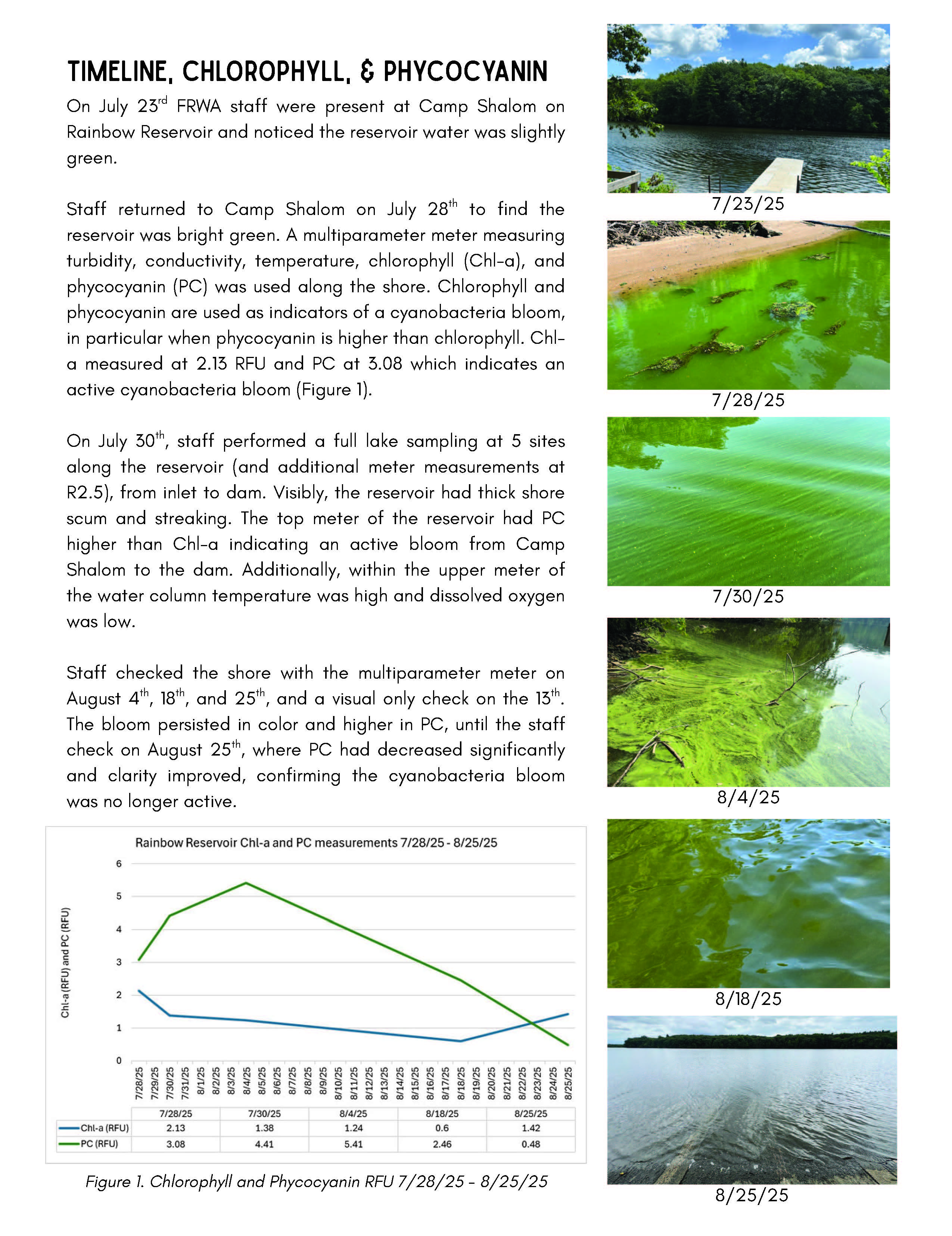Cyanobacteria
Investigation of Cyanobacteria Blooms in Rainbow Reservoir (Farmington River) Windsor, CT.

The summer of 2025 had an active cyanobacteria (aka Harmful Algal Bloom) on Rainbow Reservior in Windsor, CT.
FRWA has concluded the 2025 cyanobacteria research at Rainbow Reservoir, a 240-acre impoundment on the Farmington River in Windsor. The goal of this project was to continue our 2021 study to investigate cyanobacteria blooms in Rainbow Reservoir to evaluate bloom occurrence, causative agents and remedial options. Limnologist, Dr. Kenneth Wagner designed our study and directed the project.
This project has been funded by the CT DEEP Aquatic Invasive Species Grant Program and by the Lower Farmington River and Salomon Brookk Wild & Scenic Committee.
The project began with an initial data review to examine existing water monitoring data for the reservoir and upstream watershed. FRWA staff assessed Rainbow Reservoir for algae, nutrients, thermal and oxygen status, and sediment physical and chemical features. The data has been analyzed, potential causes identified, and recommendations reported to CT DEEP.
2025 Rainbow Reservior Cyanobacteria Summary Report
2024 Rainbow Reservoir Cyanobacteria Report
2023 Rainbow Reservoir Cyanobacteria Report
2021 Rainbow Reservoir Cyanobacteria Report
What are Cyanobacteria?
Cyanobacteria, commonly referred to as blue-green algae, are single-celled microscopic organisms that live in all types of water and use sunlight to produce food. Cyanobacteria blooms occur in slow-moving, warm water, with high levels of phosphorus and nitrogen. Excessive nutrient loading provides conditions for the cyanobacteria to rapidly multiply, causing blooms that can spread across an entire waterbody. These blooms can float up and down the water column and potentially produce toxins. The water may appear cloudy, bright green to dark red, and can be thick like pea soup. Cyanobacteria blooms can also affect the water quality by blocking sunlight and using up oxygen and nutrients that other aquatic organisms need to survive.
How do Cyanobacteria blooms affect me?
There is no clear or easy way to quickly determine if a bloom is toxic, therefore when blooms occur health officials advise people and pets to avoid the water. Cyanobacteria toxins are among the most powerful natural poisons known. Cyanobacteria blooms – due to this risk of cyanotoxins – can harm people, animals, the aquatic ecosystem, drinking water supplies, the economy, property values and recreational activities such as swimming and fishing. Not all cyanobacteria blooms produce toxins, however, about 1 in 5 blooms do. There are potential health risks for swimmers, boaters, pets and wildlife encountering toxins that may be produced by the algae. Pets swimming in waters containing cyanobacteria toxins may become ill or die after drinking or licking themselves. Toxins associated with cyanobacteria have also been implicated as the cause of mass mortalities of fish and birds.
For information and resources on cyanobacteria from the CT Department of Public Health visit here.
For information and resources on cyanobacteria from the CT Department of Energy and Environmental Protection visit here.
How do I report a Cyanobacteria bloom?
Become a citizen scientist and help report cyanobacteria bloom sightings by downloading the bloomWatch app, created by the EPA. Contact your Local Public Health Agency, CT Department of Public Health (860-509-7758), or CT Department of Energy and Environmental Protection (860-424-3020), deep.algalblooms@ct.gov.

Funding provided by the Grants for the Control of Aquatic Invasive Species Program administered by the Connecticut Department of Energy and Environmental Protection (DEEP)
North American Lake Management Society
The NALMS mission is to forge partnerships among citizens, scientists, and professionals to foster the management and protection of lakes and reservoirs for today and tomorrow. To view their resources visit NALMS. NALMS is not focused on professionals, academic researchers, or any smaller interest group alone. Rather NALMS is a melting pot, welcoming anyone interested in lakes. For information on what you can do to help manage your lake or reservoir, here are simple, concrete steps you can take in your home, yard, and local community, available at Your Lake and You.
